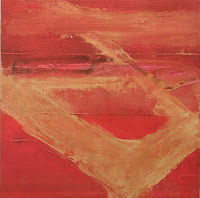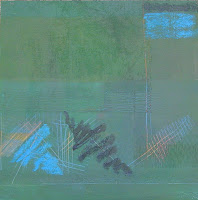
The time has come (walrus or no) to pull together a couple of montages (I'm not happy with that term; I need to consult a thesaurus). I am comfortable enough with what I'm doing to include a few pieces in my show in July -- and I have two or three more weeks to finish those. However, the gallery wants a photograph for the show announcement, and they need it this coming week. So I need to find at least one grouping that I like. (Although as I write this, it occurs to me that the photo on the announcement need not be of a final arrangement, just one that I don't mind showing to the public. It needn't be bolted together, and the components could be moved around after the photo is taken. Hmmm.)
At any rate, the issue of using intuition versus using "rules", or using a balance or blend of the two, raises its head again as I start to look seriously at multi-panel arrangements. Creating each separate panel, I still debate the intuition-vs-formal-criteria question in my mind, but I've gotten used to doing so, and can switch back and forth between the two modes, at least to some extent. I haven't really stopped to analyze when I'm using intuition and when I'm thinking about value, composition, balance, etc., but I sense that I am using both as I put down and texturize paint.
As I've moved panels around into different arrangements over the last couple of days, I have used some conscious criteria, such as the color variation that I mentioned in my last post. Anticipating final decisions, I find myself seeking something more concrete than intuition. The few formal criteria of which I've been aware are things like too much (or too little) obvious pattern, too harsh (or too subtle) a color contrast, colors that work together or don't, lack of focus or too many foci. But these specifics arise more frequently as questions (is this arrangement too fussy? do those two colors work next to each other?) than as answers. When I do come up with an arrangement I like, such as the one above, I don't always know why, and I wish I did. On the other hand (or am I getting too self-consciously fussy here?), I'm not seeking a how-to document, and I do like using my intuition. I'd like to have a master checklist of "montage criteria" to use as a tool when I want to, and also to use in fine-tuning my intuition over time. I'm not sure they would be the same criteria that I use in creating individual panels, although I'm sure there would be some overlap.
I suppose that with time I will become more comfortable with my process of arranging panels, just as I am becoming more comfortable with my process of painting them. Also, as I get some positive (I hope) feedback about this new direction in my work, I will feel more self-confident about the mix of intuition and criteria that I naturally use. Meantime, I think I'll work on that master list....









